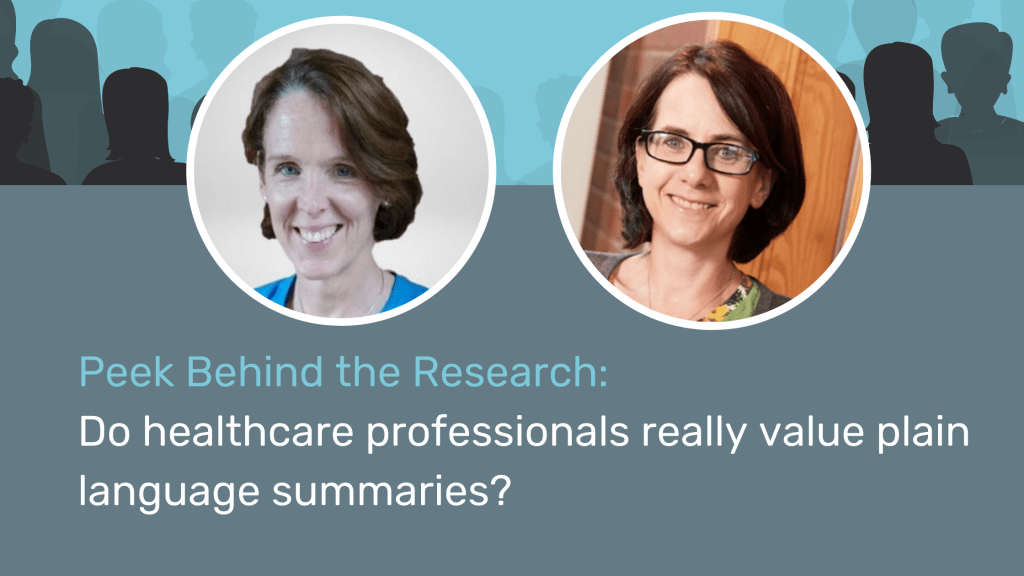- Written by Joanne Walker
Peek Behind the Research: Do healthcare professionals really value plain language summaries?
In another ‘Peek Behind the Research’ interview from the 2022 European Meeting of the International Society for Medical Publication Professionals (ISMPP), Dawn Lobban and Jacqui Oliver from Envision Pharma Group talk about their work looking at what healthcare professionals think about plain language summaries.
Read our interview about the research ‘Do healthcare professionals really value plain language summaries?’ below or access the poster here.
ISMPP-EU-2022-Do-healthcare-professionals-really-value-plain-language-summaries
Source: ‘Do healthcare professionals really value plain language summaries?‘ originally presented at the 2022 European Meeting of ISMPP, January 2022.

Why did you carry out this research?
It is evident that there is growing interest in developing plain language summaries (PLS) to accompany research publications. PLS can extend the reach of data to a broad range of audiences including time-poor healthcare professionals (HCPs) and patients. One question we often hear is – What is the value of PLS? We were keen to understand the views of HCPs on PLS and if they actually use or share these summaries to facilitate conversations with patients and family members. Using an online survey, we evaluated readership of different types of publication enhancements (PLS with text and visuals; infographic; video). These enhancements accompanied five chapters in a special issue on Type 2 diabetes (The Journal of Family Practice and Clinician Reviews).
What were the main findings?
Among the HCPs who viewed at least one of the publication enhancements, PLS were considered to be the most useful enhancement. Around 7 in 10 HCPs (71%) rated PLS as “very/extremely useful” compared with 65% for infographics and 64% for videos. This was consistent across professions: physicians, nurse practitioners and physician assistants. Of interest, of the HCPs who rated PLS as “very/extremely useful”, around half (20/47) went on to use them with their patients.
Were you surprised by any of the results?
It is really encouraging to see that HCPs are not only using PLS with patients, they are also directing patients and family members to the online PLS. Around 1 in 6 HCPs (who rated PLS as “very/extremely useful”) directed their patients and family members to the online PLS. This shows that PLS can be valuable tools for HCPs and patients to share healthcare information presented in an easy-to-understand format.
Are you looking to continue this research further?
We are keen to learn more about who is reading PLS and how they are accessing them. While this study demonstrated the value of PLS for HCPs, it would be good to understand if PLS are also valued by patient populations. Indeed, are patients, who are less familiar with journal articles and platforms such as PubMed, even aware of PLS? Further studies are needed to determine who is accessing PLS, how they are finding them and what value they provide.
Finally, what are your thoughts on the future of PLS and their place in medical/scientific research?
Dawn: It is great to see a growing interest in PLS of medical publications, reflected in the steady increase in numbers of published PLS in PubMed during the last 5 years. As we look to the future, we need to consider how these important summaries can be optimised to broaden the reach of science to lay audiences. Format is key, with visual and infographic elements shown to improve understanding compared with text-only summaries. Accessibility and sharing are also important considerations, facilitated by open access journals, searchable repositories, and social media. Translations into multiple languages ensure that science is shared worldwide.
Jacqui: Research publications are increasingly including PLS alongside the original scientific abstract, which is a great start to improving accessibility to scientific research. We need to make sure PLS are available in the right channels which may include social media channels so that patients and other audiences can actually find them. As people learn in different ways, providing PLS in different formats (text-only, text with visuals, infographics, videos) could improve dissemination of research results to those who seek this information and provide bite-sized summaries which are easy to share.
Acknowledgements: Dawn and Jacqui would like to thank their co-authors on this research, Marissa Buttaro (Envision Pharma Group), David Falleni (Frontline Medical Communications) and Melissa McGrath (GlaxoSmithKline).
